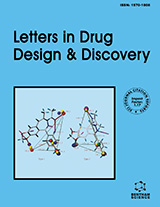Abstract
In this review we present algorithms for classification and taxonomy based on information entropy, followed by structure-activity relationship (SAR) models for the inhibition of human prostate carcinoma cell line DU-145 by 26 derivatives of N-aryl-N-(3-aryl-1,2,4-oxadiazol-5-yl)amines (NNAs). The NNAs are classified using two characteristic chemical properties based on different regions of the molecules. A table of periodic properties of inhibitors of DU-145 human prostate carcinoma cell line is obtained based on structural features from the amine moiety and from the oxadiazole ring. Inhibitors in the same group and period of the periodic table are predicted to have highly similar properties, and those located only in the same group will present moderate similarity. The results of a virtual screening campaign are presented.
Keywords: Structure-activity relationship; SAR; virtual screening; equipartition conjecture; Information entropy; N-aryl-N-(3-aryl-1, 2, 4-oxadiazol-5-yl)amine derivative; periodic law; periodic property; periodic table.
Current Computer-Aided Drug Design
Title:Information Theoretic Entropy for Molecular Classification: Oxadiazolamines as Potential Therapeutic Agents
Volume: 9 Issue: 2
Author(s): Francisco Torrens and Gloria Castellano
Affiliation:
Keywords: Structure-activity relationship; SAR; virtual screening; equipartition conjecture; Information entropy; N-aryl-N-(3-aryl-1, 2, 4-oxadiazol-5-yl)amine derivative; periodic law; periodic property; periodic table.
Abstract: In this review we present algorithms for classification and taxonomy based on information entropy, followed by structure-activity relationship (SAR) models for the inhibition of human prostate carcinoma cell line DU-145 by 26 derivatives of N-aryl-N-(3-aryl-1,2,4-oxadiazol-5-yl)amines (NNAs). The NNAs are classified using two characteristic chemical properties based on different regions of the molecules. A table of periodic properties of inhibitors of DU-145 human prostate carcinoma cell line is obtained based on structural features from the amine moiety and from the oxadiazole ring. Inhibitors in the same group and period of the periodic table are predicted to have highly similar properties, and those located only in the same group will present moderate similarity. The results of a virtual screening campaign are presented.
Export Options
About this article
Cite this article as:
Torrens Francisco and Castellano Gloria, Information Theoretic Entropy for Molecular Classification: Oxadiazolamines as Potential Therapeutic Agents, Current Computer-Aided Drug Design 2013; 9 (2) . https://dx.doi.org/10.2174/1573409911309020009
| DOI https://dx.doi.org/10.2174/1573409911309020009 |
Print ISSN 1573-4099 |
| Publisher Name Bentham Science Publisher |
Online ISSN 1875-6697 |
 11
11
- Author Guidelines
- Bentham Author Support Services (BASS)
- Graphical Abstracts
- Fabricating and Stating False Information
- Research Misconduct
- Post Publication Discussions and Corrections
- Publishing Ethics and Rectitude
- Increase Visibility of Your Article
- Archiving Policies
- Peer Review Workflow
- Order Your Article Before Print
- Promote Your Article
- Manuscript Transfer Facility
- Editorial Policies
- Allegations from Whistleblowers
Related Articles
-
Development of Anticancer Agents from Plant-Derived Sesquiterpene Lactones
Current Medicinal Chemistry Blocking the PI3K/PKB Pathway in Tumor Cells
Current Medicinal Chemistry - Anti-Cancer Agents Editorial [ Hot Topic-II: Zinc Metallo-Enzymes as Target for Drug Design (Guest Editor: Giuseppina De Simone )]
Current Medicinal Chemistry The Role of Histone Demethylase GASC1 in Cancer and its Therapeutic Potential
Current Cancer Therapy Reviews In Vitro Regulatory Effect of Epididymal Serpin CRES on Protease Activity of Proprotein Convertase PC4/PCSK4
Current Molecular Medicine Patent Annotations
Recent Patents on Anti-Cancer Drug Discovery Increasing Sensitivity to Radiotherapy and Chemotherapy by Using Novel Biological Agents that Alter the Tumor Microenvironment
Current Molecular Medicine Polyethylenimine as a Promising Vector for Targeted siRNA Delivery
Current Clinical Pharmacology Next-Generation Anticancer Metallodrugs
Current Topics in Medicinal Chemistry Epigenetic Aberrations and Targeted Epigenetic Therapy of Esophageal Cancer
Current Cancer Drug Targets Multiligand Endocytosis and Congenital Defects: Roles of Cubilin, Megalin and Amnionless
Current Pharmaceutical Design Recent Progress of Small Molecular VEGFR Inhibitors as Anticancer Agents
Mini-Reviews in Medicinal Chemistry In Silico and Biochemical Analyses Identify Quinone Reductase 2 as a Target of Piceatannol
Current Medicinal Chemistry The Role of Melatonin in Multiple Sclerosis, Huntington's Disease and Cerebral Ischemia
CNS & Neurological Disorders - Drug Targets Testosterone as Potential Effective Therapy in Treatment of Obesity in Men with Testosterone Deficiency: A Review
Current Diabetes Reviews Kallikrein-Kinin System Mediated Inflammation in Alzheimers Disease In Vivo
Current Alzheimer Research Vitamin D and Vitamin D Analogs in Cancer Treatment
Current Drug Targets Overview of Tumor-Associated Antigens (TAAs) as Potential Therapeutic Targets for Prostate Cancer Therapy
Current Cancer Therapy Reviews Tobacco, Inflammation, and Respiratory Tract Cancer
Current Pharmaceutical Design RNAi Screening for the Discovery of Novel Modulators of Human Disease
Current Pharmaceutical Biotechnology


























